Bronze cookware has a rich history and holds cultural significance in various parts of the world. Here are some traditions and aspects associated with bronze cookware:
Historical Significance:
Bronze has been used for centuries in various cultures as a material for making cookware due to its durability, heat conductivity, and malleability. Ancient civilizations such as the Greeks, Romans, Indus Valley and Chinese used bronze cookware extensively. These traditions have influenced the use and craftsmanship of bronze cookware to this day.
Craftsmanship:
Bronze cookware often involves intricate craftsmanship. Skilled artisans create these pieces using traditional methods, including casting and hammering. The process of crafting bronze cookware can be seen as an art form, and the techniques have been passed down through generations.
Culinary Traditions:
Certain cuisines have strong connections with bronze cookware. For example, in Italian cuisine, traditional copper and bronze pots are used for making risotto and polenta. The even heat distribution of bronze helps achieve precise cooking temperatures for such dishes.
Rituals and Ceremonies:
In India, bronze vessels known as "urulis" are used in traditional ceremonies, and they are often placed in homes with water and floating flowers as a form of decoration and symbolism.
Cultural Symbolism:
Bronze cookware can hold cultural and symbolic meanings. In some societies, bronze is associated with wealth, strength, and longevity. The use of bronze cookware in certain rituals or everyday cooking might carry a deeper cultural significance.
Connection to Traditional Cooking Methods:
Bronze cookware is often favoured by those who value traditional cooking methods. The unique properties of bronze, such as its heat conductivity and responsiveness to temperature changes, make it suitable for techniques that require precision and control.
Sustainability and Health Considerations:
Bronze cookware is often considered a more sustainable choice compared to modern nonstick pans, as it is durable and has a longer lifespan. Additionally, many people believe that cooking in bronze cookware is healthier compared to using certain nonstick coatings that may release harmful compounds at high temperatures.
Collectability and Heritage:
Vintage or antique bronze cookware is often collected for its historical value, craftsmanship, and cultural significance. These pieces may be cherished as family heirlooms or displayed as decorative items.
It's important to note that while bronze cookware has these traditions and qualities, its usage might not be as common in modern kitchens due to the availability of other materials like stainless steel, cast iron, and nonstick coatings. Nonetheless, the traditions and cultural connections associated with bronze cookware continue to be appreciated by those who value its unique qualities and historical significance.
Lost wax method
In order to understand the process of making traditional bronze cookware, we need to go back in time by over 5000 years to the creation of the lost wax method, that enabled the earlier civilization to make amazing bronze figurines and eventually cookware that is ubiquitously used for cooking.
Origin of Lost wax method
The lost-wax casting method, also known as investment casting, is an ancient technique used to create bronze objects, including cookware. This method has been employed by various cultures throughout history, and its origins date back thousands of years. The exact origin of the lost-wax casting method is not definitively known, but it has been used by several ancient civilizations independently.
Here's a general overview of the lost-wax casting process and its potential origins:
Process Overview:
The lost-wax casting method involves creating a detailed wax model of the object to be cast. This wax model is then covered in multiple layers of a refractory material to create a mold. Once the mold is heated, the wax melts and is "lost," leaving behind a hollow space in the mold that corresponds to the desired shape. Molten bronze is then poured into the mold, filling the void left by the melted wax. After the bronze cools and solidifies, the mold is broken away to reveal the bronze object, which can then be finished and polished.
Possible Origins:
- Mesopotamia: One of the earliest known instances of lost-wax casting dates back to ancient Mesopotamia (modern-day Iraq) around 3500 BCE. Archaeological findings suggest that the Sumerians used this method to create intricate metal objects, including small statues and ornaments. These early uses might have eventually led to the development of casting techniques for more utilitarian objects like cookware.
- Egypt: Ancient Egyptian culture also employed lost-wax casting to create metal artifacts, such as jewelry, figurines, and ceremonial objects. The Egyptians' advanced metallurgical knowledge and artistic skills likely contributed to the spread of this technique to other civilizations.
- Indus Valley Civilization: The lost-wax casting method is believed to have been used by the Indus Valley Civilization, which existed around 3300–1300 BCE in present-day India and Pakistan. Archaeological discoveries have revealed intricate bronze objects that could have been made using this method.
- China: The lost-wax casting technique was also utilized in ancient China, where bronze objects played a significant role in ritual ceremonies and daily life. The Shang and Zhou dynasties (around 16th–3rd centuries BCE) produced elaborate bronze vessels and cookware using this method.
- Other Ancient Cultures: The lost-wax casting method was not limited to these cultures. It has been identified in various other regions, including Africa, Europe, and Central and South America. Each culture adapted the method to suit its own artistic and functional needs.
While the exact origin of the lost-wax casting method remains uncertain due to its widespread use across different ancient civilizations, it is clear that the technique's development was influenced by the advancement of metalworking skills and artistic expressions throughout history. Over time, the method evolved and was refined, contributing to the creation of various bronze objects, including cookware, that hold historical and cultural significance.
The Process Followed in Lost Wax Method
Here's an overview of the process:
- Creating the Model: The process begins with the creation of a detailed model of the object to be cast. This model can be made from using wax. The model represents the exact shape and details of the final object.
- Creating the Mold: The model is then attached to a central rod, which will serve as a channel for molten metal to enter the mold. The entire model and rod assembly is then coated with layers of refractory material (investment), which can be a fine plaster or ceramic material. This creates a mold around the model, capturing its shape and details.
- Removing the Model: The mold assembly is then heated to a high temperature, causing the wax or other model material to melt and flow out of the mold. This step is where the term "lost wax" comes from – the wax is lost during the process, leaving a cavity in the mold where the wax once was.
- Preheating the Mold: Once the wax is removed, the mold is preheated to further strengthen it and remove any remaining moisture. This helps prevent cracks and other defects during the pouring of molten metal.
- Casting: Molten metal, often bronze or another metal with similar properties, is poured into the mold through the central channel. The molten metal fills the void left by the melted wax, taking on the shape and details of the original model.
- Cooling and Solidifying: The mold is allowed to cool, causing the molten metal to solidify and take on the shape of the mold cavity.
- Breaking the Mold: Once the metal has cooled and solidified, the mold is carefully broken away to reveal the metal casting within. This may involve breaking the investment material or using other methods, depending on the specific casting.
- Finishing and Detail Work: The metal casting may require additional finishing work to remove any casting imperfections, excess metal, or the remnants of the central channel. The surface may be polished or otherwise treated to achieve the desired appearance.
The lost-wax method allows for the creation of highly detailed and intricate metal objects, capturing the nuances of the original model. It has been used for centuries across various cultures and remains a popular technique in art, sculpture, and even functional objects like cookware. The versatility and precision of the lost-wax method make it a valuable tool for producing complex metal objects.
Difference between Bronze Cookware & Kansa Serve ware:
Though both of these are made of bronze, the serve ware is made of ingots and beaten and made to serve ware shapes - this process is predominant in the northern and central part of India and these cannot be used for cooking. They will crack/break if heated to cook. The casted bronze which is made using the lost wax technique that is mastered by craftsmen in southern part of India are the only ones that can be used for cooking purpose.
Usage and Maintenance of Bronze Cookware
Using and maintaining bronze cookware requires attention to both its unique qualities and the care needed to preserve its longevity. Here's how to properly use and maintain bronze cookware:
Usage:
- Seasoning: Bronze in general do not need any seasoning. You can wash and start using them for cooking purpose.
- Preheating: Preheat your bronze cookware gradually over medium heat to ensure even heating. This prevents hot spots that can lead to uneven cooking.
- Cooking Mediums: Use cooking oils with high smoke points, such as vegetable, canola, or peanut oil, when cooking with bronze cookware. Avoid using oils that can easily burn and leave residue on the cookware's surface.
- Utensils: Opt for wooden, silicone, or nylon utensils to avoid scratching the cookware's surface.
- Temperature Control: Bronze cookware conducts heat quickly, so it's important to adjust heat levels as needed. Using medium to low heat is often sufficient to achieve desired cooking temperatures.
- Acidic Foods: Be cautious when cooking acidic foods like tomatoes or citrus-based dishes, as prolonged exposure to acids can affect the patina and flavor. Consider using lined cookware for such dishes.
- Cleaning: After cooking, allow the cookware to cool slightly before cleaning. Avoid exposing hot bronze to cold water, as this can cause warping.
Maintenance:
- Hand Washing: Wash bronze cookware by hand using mild dish soap, warm water, and a soft sponge or cloth. Avoid using abrasive scouring pads or harsh detergents that can damage the patina.
- Stubborn Stains: For stubborn stains or food residues, you can create a paste of baking soda and water, apply it to the stained area, and gently scrub.
- Drying: After washing, thoroughly dry the cookware with a clean towel to prevent water spots and corrosion.
- Storing: When not in use, store your bronze cookware in a cool, dry place. If stacking pots and pans, place a soft cloth or paper towel between them to prevent scratching.
- Polishing: If you want to maintain the shiny appearance of your bronze cookware, you can occasionally clean it with tamarind or lime skin with washing soda to get the shine back.
- Patina: Some cooks appreciate the natural patina that develops on bronze cookware over time. This patina adds character and depth to the cookware's appearance. If you prefer this look, avoid aggressive cleaning and polishing.
Properly cared for, bronze cookware can last for generations, retaining its cooking performance and aesthetic appeal. While it might require a bit more attention than modern cookware, the unique qualities of bronze make it a rewarding addition to your kitchen.
To know more details about Bronze Cookware, check our Bronze Cookware Product Detail Document!




4 comments
Kamini Shekhawat's
Order one Brass utensil yet to come let see my after using it.
Kamini Shekhawat's
Order one Brass utensil yet to come let see my after using it.
Dhameer Govind
Where can you buy bronze pots from? Any online stores?
M S Pasibabu
I want to buy 100% pure bronze heavy weight Tea glasses heavy.
Leave a comment
All comments are moderated before being published.
This site is protected by hCaptcha and the hCaptcha Privacy Policy and Terms of Service apply.